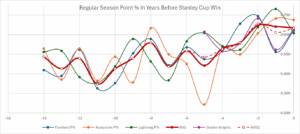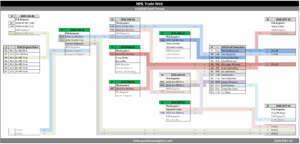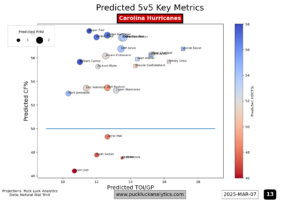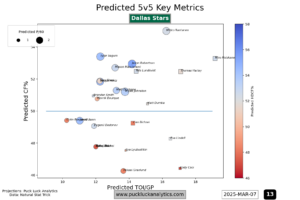I’ve been working on better understanding the value of draft picks. How likely is a second round pick to become an NHL player? If they do, where will they most likely fit in the lineup? If everything goes right, where is the ceiling and how likely are they to hit it?
Before we can get into analyzing the picks, we need to outline some player tiers to describe where players fit in the lineup. To do so, we’re going to use the 2023/2024 season and look at all players that played at least 20 NHL games.
Forwards
With 32 teams in the league and 12 forwards per team, 384 forwards make up a league-wide starting lineup. In the 2023-2024 season, there were 469 forwards that played at least 20 NHL games. We can use a couple of key stats to place those 469 forwards into tiers.
5v5 TOI/GP – Ice time can be used to get a basic understanding of how a player is used. More ice time generally means they are playing higher in the lineup, with better players, and against tougher matchups.
5v5 P/60 – Point production gives us a rudimentary sense of how well a player performs in their role. Since we’ve already limited the sample to players with at least 20 GP, it’s less prone to small sample sizes deceiving us.
Looking at these two stats together gets us our player tiers:
Elite – Forwards in the top 25% of 5v5 TOI/GP and the top 10% of 5v5 P/60. These players produce at an elite level and do it while playing in big roles. In 2023-2024, there were 28 forwards who met this criteria so there was not quite 1 elite forward per team in the NHL.
Support – Forwards in the top 50% of 5v5 TOI/GP and the top 25% of 5v5 P/60. These players are very productive in their minutes and play in notable roles, generally in the top half of the lineup. In 2023-2024, there were 63 forwards in addition to the Elite tier that met this criteria. With 91 forwards in the elite and support tiers combined, these players are considered top line players.
Contributor – Forwards in the top 75% of 5v5 TOI/GP and the top 50% of 5v5 P/60. These players play enough that they aren’t just warming the bench and they are reasonably productive when they are on the ice. In 2023-2024, there were an additional 127 players that met this criteria so these can be considered good middle six forwards. With the three tiers to this point, we have enough forwards for a top six and one third line forward.
Depth – Forwards in the top 75% of 5v5 TOI/GP and the top 75% of 5v5 P/60. These players play regularly and have somewhat limited impact from a production standpoint. In 2023-2024, there were an additional 88 players that met this criteria. That gives us about another forward line, so we have about a top nine and an extra forward to this point.
Replacement – Forwards who played at least 20 NHL games and didn’t meet the criteria for at least the depth tier are considered replaceable. They either played very little when they were in the lineup, were unable to produce, or both.
Defensemen
Using a similar method for Defensemen, we can set out a similar tiers. There’s one less for defensemen since there are only six in a starting lineup.
Elite – Defensemen in the top 75% of 5v5 TOI/GP and the top 90% of 5v5 P/60.
Support– Defensemen in the top 50% of 5v5 TOI/GP and the top 50% of 5v5 P/60.
Contributor– Defensemen in the top 25% of 5v5 TOI/GP and the top 25% of 5v5 P/60.
Replacement – The rest.
With player tiers defined, we’re ready to get to the more interesting stuff: draft picks and corresponding development profiles. Next.



